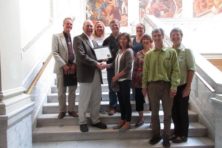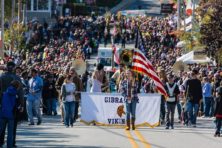Sturgeon Bay Home Added to Historic Register
- Share
- Tweet
- Pin
- Share

Briefly-used exterior material gives Soper House significance
The Dr. Joseph and Olivia Soper House in Sturgeon Bay was added to the State Register of Historic Places this month – laying the groundwork for a listing on the National Register of Historic Places, the house owner said.
The next steps, say owners Rebecca Carlton and Tony Staroska, is to finish removing modern alterations – such as suspended ceilings and layers of materials covering original pine, maple and walnut flooring – and to complete the nomination process to the National Park Service for the national designation.
Constructed in 1881, the house at 23 N. Fifth Ave. is architecturally significant to the Wisconsin Historical Society because its exterior walls are clad in locally produced Frear artificial stone, with deeply struck horizontal joints. The historical society says it’s the city’s only remaining residential example of the exterior material, which was durable but only used for a short period of time.
The house becomes the 13th place in Sturgeon Bay on the state register.
Dennis Statz, who sold the Soper House to Door County Land Trust in 2010, said the city’s only other remaining Frear stone adorns the front of AMO Gallery & Framery, 40 N. Third St.
“This early form of concrete was promoted as an affordable alternative to natural stone with the advantages of being both strong and versatile with a wide range of color tones and a nearly infinite variety of molds into which it could be cast,” according to the historical society.
The material – a short-lived but important chapter in the development of modern concrete – was manufactured by Giles Kirtland, a former superintendent at the Frear Stone Manufacturing Company in Chicago, who purchased the rights to manufacture and sell the product in Sturgeon Bay, according to the historical society.
Statz said when he bought the house from Gus and Alice Gosser in 1994, he completely redid the roofs and two garage bays, which had been separate add-ons. He said when he bought the place, many people didn’t know there was a nice house at the location – the yard had been overgrown and the house was painted all one light-green color.
Dr. Soper, a Civil War veteran, used to see patients on the first floor. During World War I and II, owners – including an early suffragette – rented three small apartments to shipyard workers, Carlton said.
Carlton said the state designation helps to ensure that the house will survive for decades to come. She also looks forward to moving into the home, which she loves both inside and out – including the native plantings and miniature woodland that the Land Trust created.
Though she did two years of research, the work and expertise of architectural historian Gail Klein made it easier to compile materials for the state designation, Carlton said.



